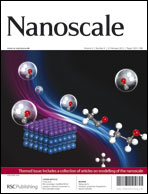Correlation between the band gap, elastic modulus, Raman shift and melting point of CdS, ZnS, and CdSe semiconductors and their size dependency
Abstract
With structural miniaturization down to the nanoscale, the detectable quantities of solid materials no longer remain constant but become tunable. For the II–VI semiconductors example, the band gap expands, the elastic modulus increases, the melting point drops, and the Raman optical phonons experience red shift associated with creation of low frequency Raman acoustic modes that undergo blue shift with decreasing the dimensional scale. In order to understand the common origin of the size dependency of these seemingly irrelevant properties, we formulated these quantities for CdS, ZnS, and CdSe semiconductors from the perspectives of bond order–length–strength correlation and the local bond averaging approach. Consistency between the theory predictions and the measured size dependence of these quantities clarified that the undercoordination-induced local strain and quantum entrapment and the varied fraction of undercoordinated atoms of the entire solid correlate these quantities and dominate their size effect.


 Please wait while we load your content...
Please wait while we load your content...